On day 4, we are able to compare “fresh” fault scarps from surface rupturing earthquakes of the 2019 Ridgecrest sequence to a fault scarp that most recently ruptured over a century ago during the 1872 Owens Valley earthquake. The Ridgecrest scarps we visit ruptured during the Mw 6.4 earthquake that occurred on July 4th, 2019 on a NE-striking fault just outside of Ridgecrest, CA; this was a foreshock to the larger Mw 7.1 event that occurred on a NW-striking fault the following day. We discuss the complexity of this rupture sequence and the new questions it raises regarding fault zone complexity, state of stress in the crust, and implications for assessing seismic hazards. We then travel to Lone Pine, where we visit the fault scarp associated with the Owens Valley Fault. This fault last ruptured in the March 26, 1872 Mw 7.4-7.5 Lone Pine Earthquake. This is a “composite” fault scarp, which means that its geomorphic expression is the result of multiple earthquake events (at least 3 past events in this case). We note how the difference in age, style of slip, and nature of what is being offset during faulting result in different morphologies in these two fault scarps. Finally, we visit the Alabama Hills, a scenic outcrop of Sierra Nevada batholith that lies at an intermediate elevation between the high peaks of the Sierra Nevada to the west, and the basement underlying Owens Valley to the east. It lies in this unique location because it is trapped between the Sierra Nevada fault zone and the Lone Pine/Owens Valley Fault zone in what is commonly referred to as a “breached relay ramp.” We discuss the geometry of normal fault systems at this location and how they evolve over time to create features such as the Alabama Hills.







